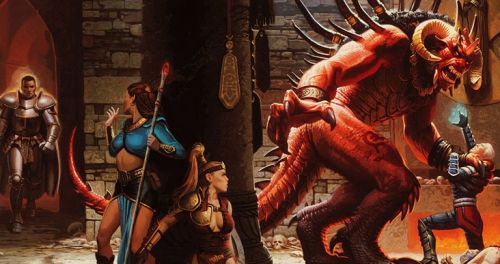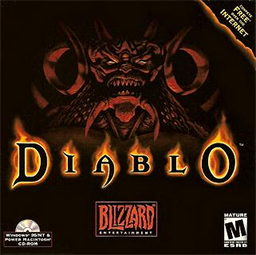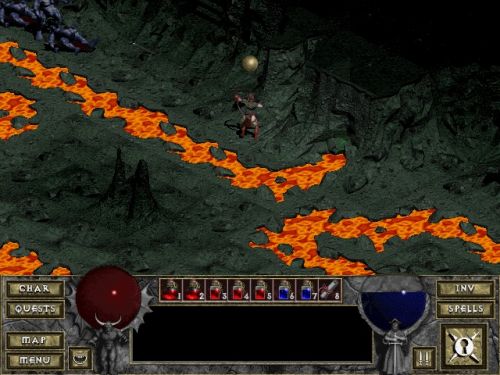

As 1996 drew to a close, a new chapter in videogame history was beginning. On December 31st of that year, Diablo was released. It was a smash hit, and forever altered the gaming landscape. Diablo was a hybrid, blending action and RPG elements together, and it was incredibly fun to play, especially in cooperative mode with a few friends. A lesser-known expansion, Hellfire, was released in late 1997. The superb sequel, Diablo 2, came along in 2000, followed by the Lord of Destruction expansion in 2001. The series is one of the most adored in video gaming, and for good reason. It went on to spawn countless successors and imitators, arguably creating a new genre, the action RPG. Today, we’ll take a look at each game and expansion in the series, tracking the evolution of Diablo in anticipation of the launch of Diablo 3 next week.

Diablo (1996)
Looking back on Diablo today, it seems very simple. There are only three classes, sixteen levels in the dungeon, and a very small town to interact in. The graphics are primitive, and the interface feels raw and unrefined. Even though fifteen years of technological improvements have passed by, Diablo’s random dungeons and loot hunting are still compelling.
The classes in Diablo included the Warrior, Rogue, and Sorcerer. Unlike the many games that followed in its footsteps, the original Diablo’s three classes don’t have much to differentiate between them. Item use is not tied to class, but instead to statistics; a rogue can wear plate armor, for instance, if she spends enough stat points in Strength. All three classes can learn all the spells in the game, provided they find the right books to teach them. The three classes are quite different than the totally unique heroes in Diablo 2 and 3.
Though they have much in common, a few things differentiate Diablo’s classes from one another. The maximum stats for each are different. At higher levels, the Warrior will have more hit points, and the Sorcerer will have more mana, for example. Class-only skills include the Warrior’s talent for repair, the Rogue’s trap detection skills, and the Sorcerer’s ability to recharge magical staves. Perhaps the most significant difference between the classes are the attack and spell-casting animations. Warriors swing weapons the quickest, and Sorcerers can cast spells faster, while Rogues are unmatched in archery.

The biggest difference from one character to the next, regardless of class, is undoubtedly the spells available to them. You learn spells by using books; as you read more books of a particular skill, the spell becomes more effective. These precious spell books drop randomly, so you can’t really plan ahead for what your character will be able to do. If you want your Sorcerer to sling fireballs left and right, that’s great... as long as you find enough books of Fireball. You may end up with a ridiculously high level in Charged Bolt or something else instead. This reliance on finding books isn’t necessarily a bad thing, as it makes every playthrough quite unique.
Diablo's setting, the town of Tristram, is quite small, and consists of only a church and a few smaller buildings. It is a simple village where the player interacts with various NPCs in order to purchase items, make repairs, and otherwise rest in between trips to the dungeon. Most of the action takes place in the sixteen levels beneath Tristram. Players begin their quest in the Church, followed by the Catacombs. Deeper down, the Caves lead to Hell itself, where Diablo is finally confronted. The dungeon level layouts, as well as the minions of Diablo who inhabit them, are randomly generated each playthrough. While Diablo certainly wasn’t the first game with random dungeons, by including them, the game’s replayability was greatly enhanced.
The original Diablo was more loot-based than the sequels would be. Remember that spells themselves were an item drop, meaning you had to keep searching in order to improve. The random treasure drops, with the famous prefix and suffix traits (Godly Plate of the Whale, anyone?) also kept you slaying Diablo’s cronies in order to improve your character long after you first beat the game. I remember spending hours starting new games just to visit Griswold’s shop in the hopes of finding a fantastic item like a King’s Longsword of Haste. The allure of finding the next item to make your character perfect is one of the biggest reasons for Diablo’s success.
And the co-op! It was glorious. Many different strategies emerged in team play, from as simple as “divide and conquer” to the classic “warrior tanks, sorcerer and rogue attack from afar” tactics. The options for connecting to your friends were robust, including LAN play, Dial-up modem, and, best of all, online play via battle.net (more on this important innovation later). You could even install a spawn version of the game, so more than one player could enjoy a limited version of the game even from one CD. Diablo was great alone, but became something truly special in co-op with your pals.
Diablo: Hellfire (1997)
Did you even remember that Diablo had an expansion? Blizzard seems to have forgotten as well, since it’s not on their list of legacy games. Hellfire was produced by Sierra, not Blizzard, which is likely the reason for this exclusion. Nontheless, it is an authorized expansion, and a fascinating one at that.
The most obvious addition to Hellfire is another class for players to choose from: the Monk. The Monk, as you might expect, excels at unarmed combat, and is the master of the staff. Monks have the ability to hit three targets with one attack, which is ideal for clearing out clumps of bad guys. To compensate for their melee offense prowess, the Monk gets less benefit than the other classes when wearing heavy armor, and they have far less max hit points than the other melee-centric class, the Warrior.
Hellfire added new levels to the game as a lengthy side quest. The Demon Crypt and Festering Nest are the two halves of the additional Hellfire content. New monsters to complement these nifty new tilesets are included. To compensate for the extra time players have to level up in the expansion, Diablo has been buffed up considerably, making him even tougher to take down.
Hellfire made some tweaks to the user interface that would make their way into the official sequel. One of the best is the ability to run in town, instead of nonchalantly walk around. There is a new spell called Search, which lights up hard to locate items and gold that have fallen on the ground. Another spell lets you warp to the nearest staircase, to assist in exploring the dungeon. New items, shrines, and even more spells, including books of extremely powerful Apocalypse and Nova, round out the additions in the expansion. Sadly, Hellfire was designed primarily as a single player experience, though a few of the interface tweaks made their way into co-op.
Diablo 2 (2000)
As good as the original Diablo was, the sequel was a vast improvement in every area. As the new milennium began, Diablo had been out for more than three years, and fans were clamoring for more. The sequel delivered, bringing more classes, a better story, awesome environments, interface tweaks, and, best of all, more loot. All of these things combined to make Diablo 2 one of the greatest sequels ever.
The best improvement had to be the huge variety in class and skill options. While the original three classes were somewhat homogenous, the classes in Diablo 2 were vastly different from one another. The Barbarian was a brutal melee force, and the other hand-to-hand focused class, the Paladin, used auras and played totally differently. The Sorceress was perhaps the most familiar, with many of the same spells as had been in the first game. The Necromancer used vile undead magic, and the Amazon, similar to the Rogue, was a force to be reckoned with whether using bows, javelins, or spears. All five classes were quite distinct from one another, a vast improvement over the sameness of the original.
A totally revised skill system replaced spellbooks. Instead of random chance determining your best attack methods, players could now choose from a virtual buffet of powerful abilities. With three different skill trees available, even characters of the same class could play much differently from one another. The Necromancer was a great example; a Necro skilled in Summoning could hang back and let the pet do the work, while one focused on the Curse tree could debilitate Diablo’s minions, greatly reducing their strength. With five classes and many different viable builds for each, there was something new to try every time you played.
Another major change to Diablo 2 was the scale of the game, both the environments and the story itself. No longer was the player stuck in a dungeon beneath one small town. Throughout the four acts, the story took players from a bleak desert to a lush jungle to the plane of Pandemonium. Though dungeons were scattered throughout the game, a good portion of the action took place in large open areas, adding a sense of exploration and discovery to the experience. The storyline was quite satisfying, tying in nicely to the original game but adding an epic, world-shattering significance to the quest.
While the beloved prefix and suffix item system would return, it was greatly enhanced by the addition of socketed items and crafting. Various gems of different sizes and properties dropped throughout the game. These gems could be placed into socketed items, allowing you to customize a weapon or piece of armor to your exact needs. The greatest quest item ever, the Horadric Cube, gave you additional backpack space and allowed you to transmute items. Small gems could be combined into larger ones, potions and common weapons could be altered, and even rare items could be improved, if you knew the right combination. Diablo 2 was a loot fan's dream, with something new and better to look forward to no matter what level you were.
Many of the more tedious elements of the original Diablo were fixed, or at least addressed, in the sequel. Books of Town Portal and Identify saved space in your backpack, and the stash gave you more room to put your beloved loot, which could then be shared with other characters. Waypoints placed regularly throughout the expansive world greatly reduced downtime, and so did the new run ability, provided you had enough stamina. Minions could be hired in each act to assist on the quest, and added greatly to your chances of survival. Small changes, perhaps, but they made a big difference.
The strong co-op elements of the first game were improved in the sequel. Better battle.net integration, with a more security and precautions in place to avoid cheating and griefing, let you team up easily. The various classes covered each other’s weaknesses well. Sorceresses froze monsters in their tracks so their friends could take them down. Paladin auras buffed the entire group, as did some Barbarian warcries. Most classes had some way to help others, adding much to the sense of teamwork and cooperation. Diablo 2 took everything that made the original great, changed what didn’t work, and added in so much value that it, too, became extremely popular.
Diablo 2: Lord of Destruction (2001)
Though it came just a year after Diablo 2, Lord of Destruction made significant changes and refinements to the base game. Considering Diablo 2 was great to start, it was no small task to improve it. Unlike Hellfire, Lord of Destruction was developed in house by Blizzard themselves. New classes, a new act, and even more crafting options became available in this expansion.
The Assassin and Druid took the total number of classes available to a robust seven. They didn’t step on the other classes’ toes, carving out their own niche and playstyle. The Assassin was a deadly martial artist, capable of all sorts of devious tricks. Fist weapons were a specialty, and with whirling claws, powered-up finishing moves, and traps, the Assassin was lots of fun to play. The Druid was a nature-based spellcaster, among the most versatile in the game. A druid could focus on shapeshifting skills, concentrate on summoning the elements, or call upon plants and animals for assistance. Both classes were certainly worthy additions to the game.
A new ending act, set atop a mountain in barbarian highlands, continued the stellar storyline. One of the greatest levels in all of video gaming was the first area, the Bloody Foothills. You are plunged immediately into a massive battlefield filled with demons and barbarians. Other locations included ice caverns and a demonic temple, and these were filled with new, tough monsters. The big bad boss at the end of Act V was Baal, another ancient evil on par with Diablo himself.
For fans of powerful magic items (basically everyone who ever played Diablo), Lord of Destruction added many shiny new things to collect. Runes and jewels could be found, and added to socketed items. Runes were particularly addicting because they could be merged in all sorts of combinations, giving some of the best abilities in the game. Charms were an interesting addition, taking up inventory space but granting precious bonuses. Class specific sets and ethereal items, powerful but unable to be repaired, kept players clicking and killing in order to find them.
By anyone’s measure, Lord of Destruction was a fantastic expansion. It took what was already one of the best games ever, and made it something legendary. Diablo 2, with the improvements from Lord of Destruction, is by far the greatest game in the series (until next week, at least) and is arguably one of the greatest video games of all time.
Battle.net and Legacy Support
For fans of co-op, perhaps the greatest thing about the Diablo series is Blizzard’s peerless battle.net service. There were very few similar services out there when the first Diablo launched, and even fewer of them were free. Connecting to battle.net gave you a reliable method of playing multiplayer games online with your friends. For many people, playing one of the Diablo games on battle.net was the first experience they had with online co-op. In this era when the online servers for games are taken down within a period of months at times, battle.net is still going strong, supporting both games even after more than a decade has passed since their release.
Similarly, Blizzard has worked diligently to improve Diablo and Diablo 2, fixing bugs and increasing support, for many years. The most recent patch for Diablo 2 was released in 2010, and made significant improvements, including the much-requested free respec, where players could reallocate their skill points. Their ladder system, where players can restart in a clean environment, releases new seasons often; in fact, a new ladder reset happened earlier this month. This level of support for legacy games is unequaled in the industry.
Without a doubt, Diablo and Diablo 2 are among the most influential titles in video game history. The combination of gothic horror, RPG elements, an easy interface, and the endless pursuit of character advancement through better items and skills, along with impeccable co-op options, merged into something truly special. If it wasn’t the birth of the action/RPG genre, it was the most important step in its development. Soon, we’ll all be playing Diablo 3, and clicking our way through Hell once again.
If past history repeats itself, we’ll be playing this latest Diablo game for a dozen years. Think how much your life has changed in that time. Some of our readers might not even have been born when the original Diablo was released on New Year's Eve in 1996. If the latest game and any subsequent sequels remain as popular as the first two games have been, Diablo will become a truly cross-generational series, an establishment in video game culture, for decades to come.